A Piece of a Giant Jigsaw: a newly re-discovered pot from Naqada
By Alice Stevenson, on 11 March 2014
A garage in Cornwall, UK, seems an unlikely place for a piece of prehistoric Egyptian culture to turn up. But a few months ago it did.
I was recently contacted by a couple, Guy Funnell and Amanda Hawkins, who had just watched the BBC documentary The Man Who Discovered Egypt which profiled the career of Flinders Petrie. The name rang a bell and reminded them of a little broken pot they had tucked away in storage. Associated with it was a yellow, curling label bearing the title ‘Libyan Pottery’
The vase this note relates to is not something we would call ‘Libyan Pottery’ today. Nowadays we can recognise it as distinctly Egyptian and characteristically Predynastic.
It is a classic example of what Petrie called ‘Black-topped pottery’ or ‘B-ware’. His excavations at the huge cemetery of Naqada had revealed hundreds of such vessels, which were so striking that he first described them as ‘wholly un-Egyptian’. Instead, Petrie thought that these things belonged to a ‘New Race’, possibly invaders from Libya.
His discoveries were widely publicised. They were also widely distributed. In the 1960s Elise Baumgartel scoured the world for the whereabouts of the finds from Petrie’s fieldwork at Naqada. Her subsequent publication listed many of the museums that benefitted from the finds distribution of the season at Naqada.
But not everything ended up in an institution. Clearly token items found their way into private hands. In the case of this little pot from Cornwall the story goes that it was received by Guy Funnell’s grandfather, Charles Funnell, who was a taxi driver in the High Wycombe area of Buckinghamshire in the 1950s. One day, in recompense for a series of unpaid chauffeur bills, a customer offered a more unusual type of compensation: a Predynastic black-topped pottery vessel excavated by Petrie at Naqada. The name of that customer is currently uncertain. While their identity remains obscure, the 19th-century story of the pot’s discovery and the 4th millennium BC context of its use is, thanks to that label, clear. The numeral written on the top of the card, and inked on the base of the vessel, is 1754. That is the number of the grave in which the pot was found and leads us to the Petrie Museum archives where the excavator’s record of tomb 1754 are kept.
The recorder of this find, James Quibell, documents here a number of artefacts from grave 1754. We only know the present-day location of four of them: a set of shells (UC4658) and fragment of rock crystal (UC4659) here in the Petrie Museum, and a red polished P-ware bowl in Oxford’s Ashmolean Museum (1959.274). Notably the latter has a 1950s accession number as it came to the Ashmolean not in the first distribution of material from Naqada but by way of the collection of Joseph Grafton Milne, the Deputy Keeper of Coins at the Museum. He had first visited Egypt in 1895–96, where he spent time with Petrie. The dates all fit. Could Milne, or another member of his family, be the mystery taxi passenger?
That’s not the only question this pot prompts, however. Where are the other objects from grave 1754? The fact that effort was put into printing and designing a label suggests that this was not a one off. So how many other artefacts from prehistoric Egypt might be unknowingly concealed in a garage, a cupboard or in an attic?
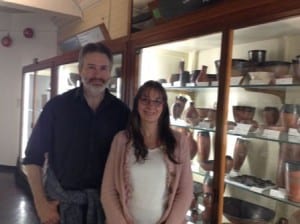
Guy Funnell and Amanda Hawkins in the Petrie pottery gallery beside Predynatic black-topped pottery.
For the time being the pot from Cornwall is not hidden away. Guy and Amanda have generously loaned the vessel to the Petrie Museum for one year, where UCL Museums’ conservator, Susi Pancaldo, will treat its bumps and bruises so that it can be put on display in June as part of our ‘Festival of Pots’. We will also undertake research into its history. In the meantime, if you know of any labels similar to the one found with this pot, please let us know as it could be another clue in a global jigsaw of the thousands of artefacts first found 120 years ago.
3 Responses to “A Piece of a Giant Jigsaw: a newly re-discovered pot from Naqada”
- 1
- 2
- 3
 Close
Close


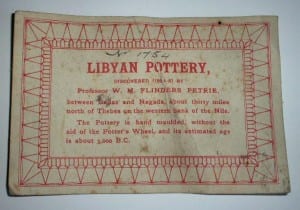
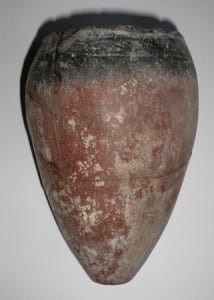
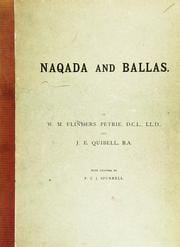
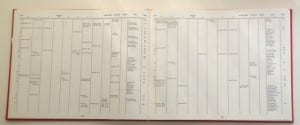



Very interesting blog – thanks.